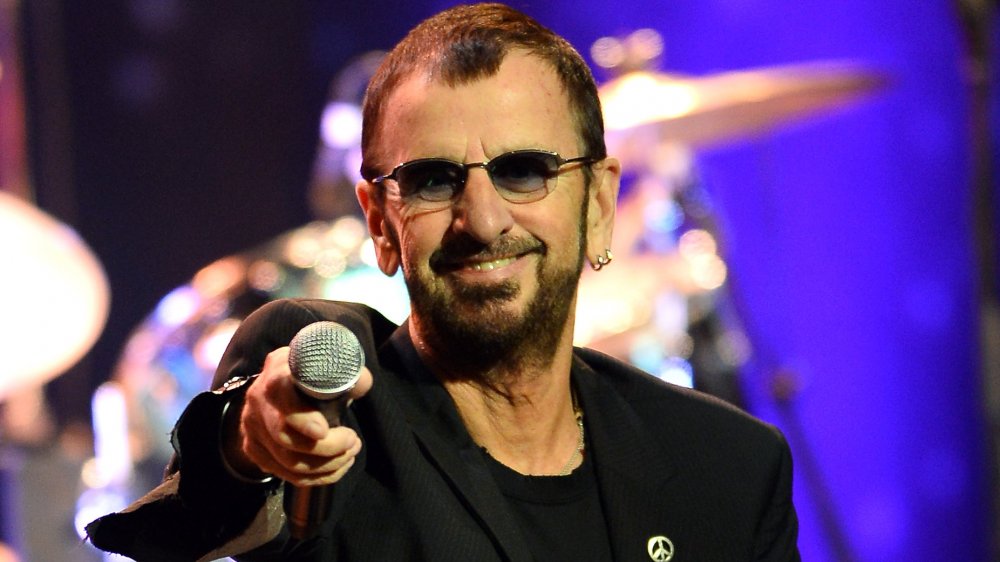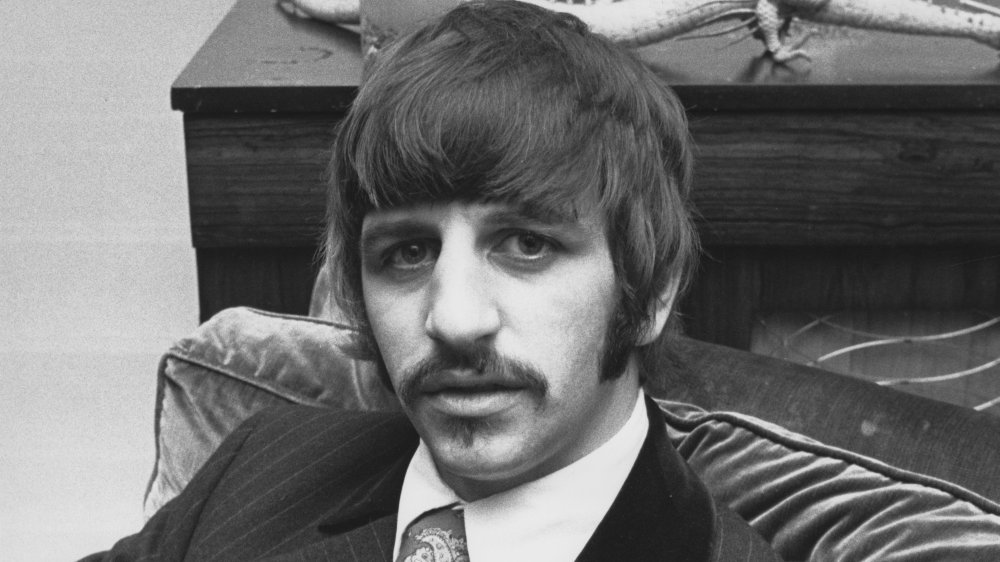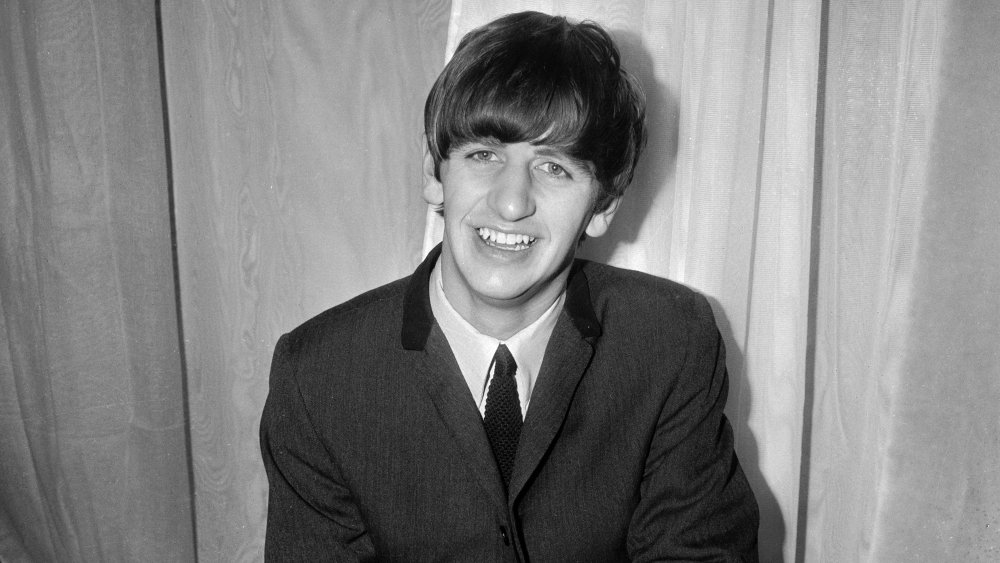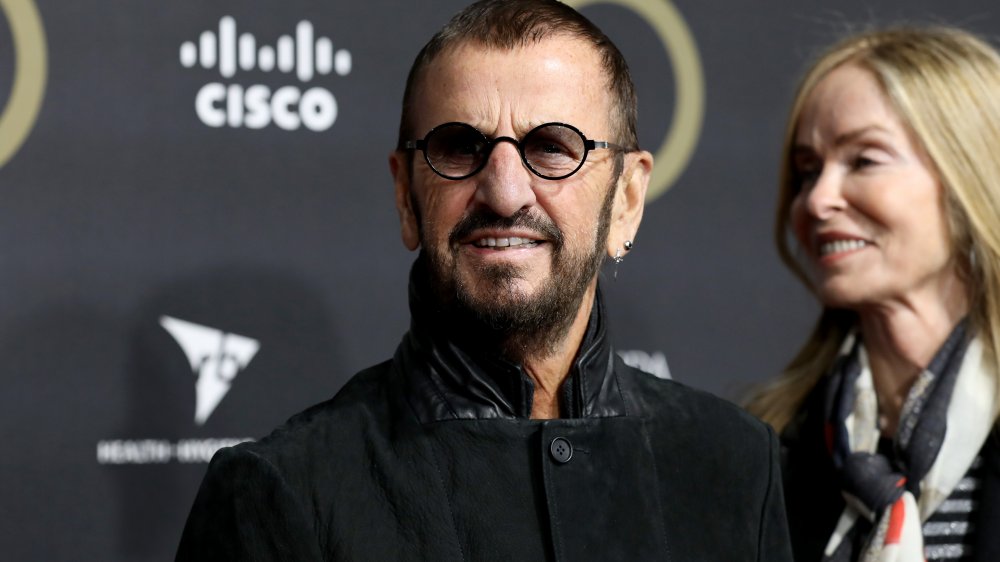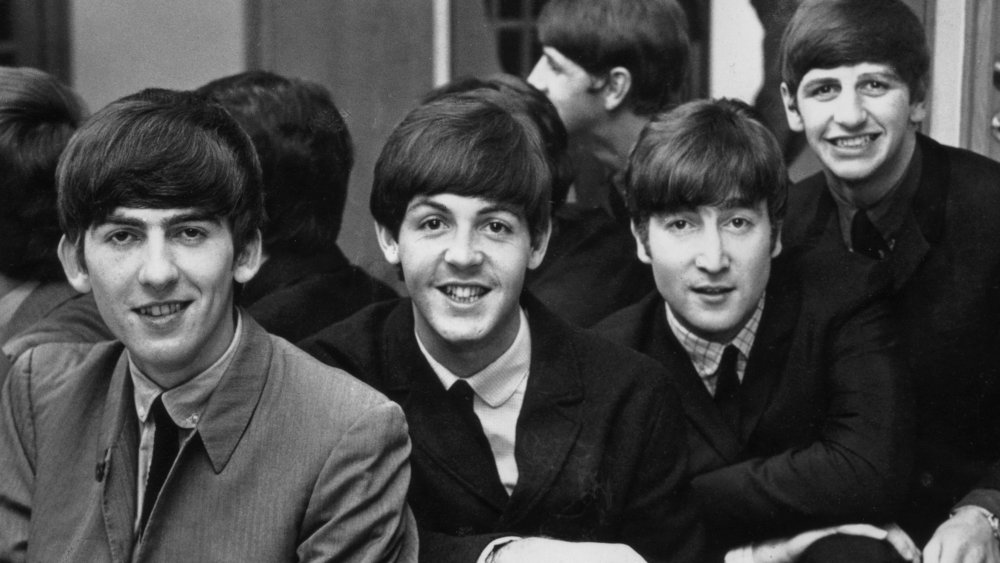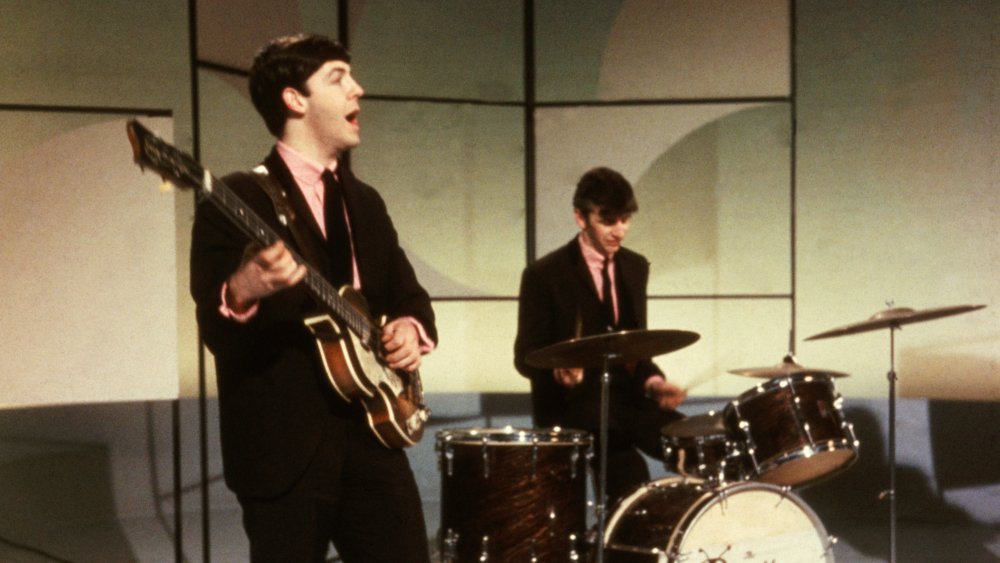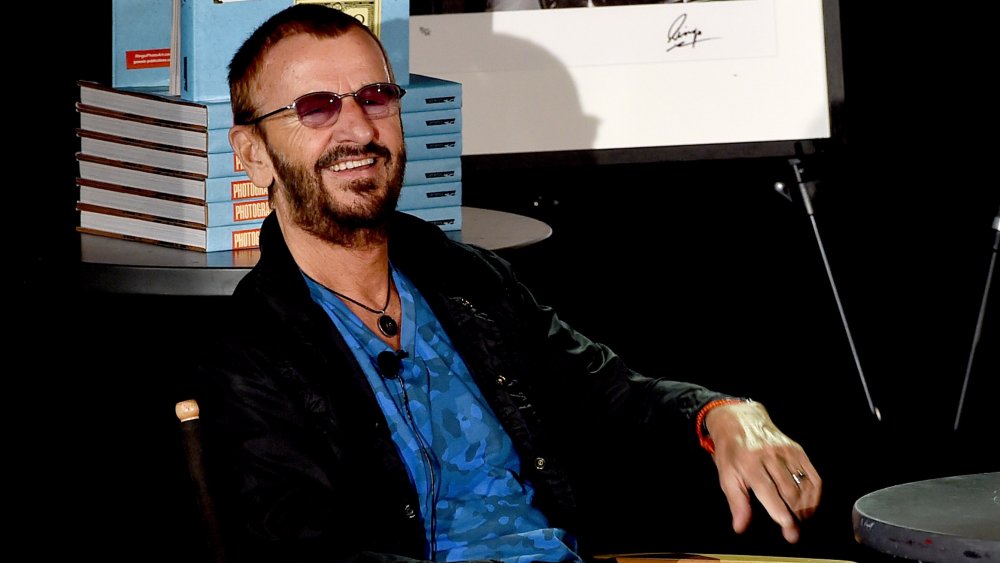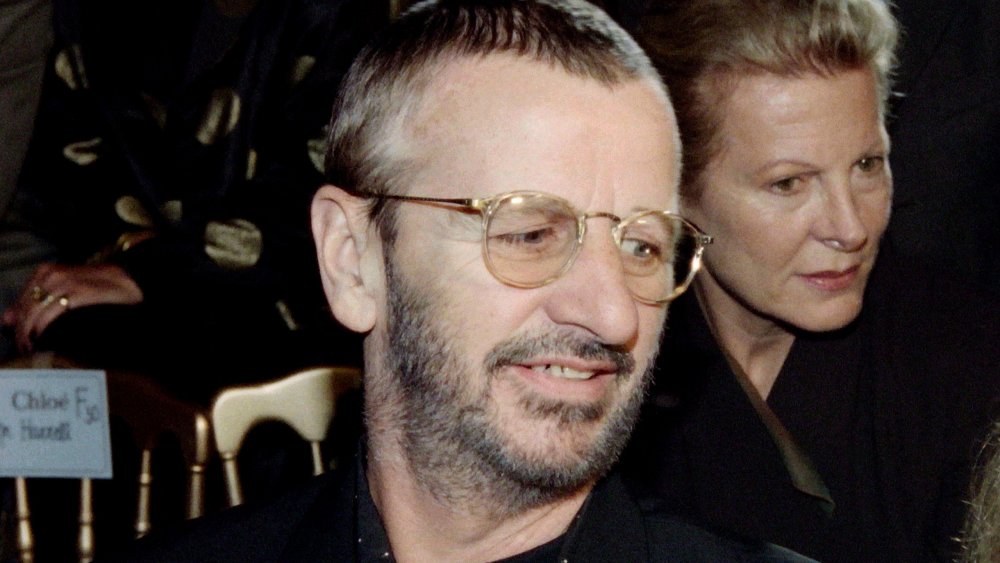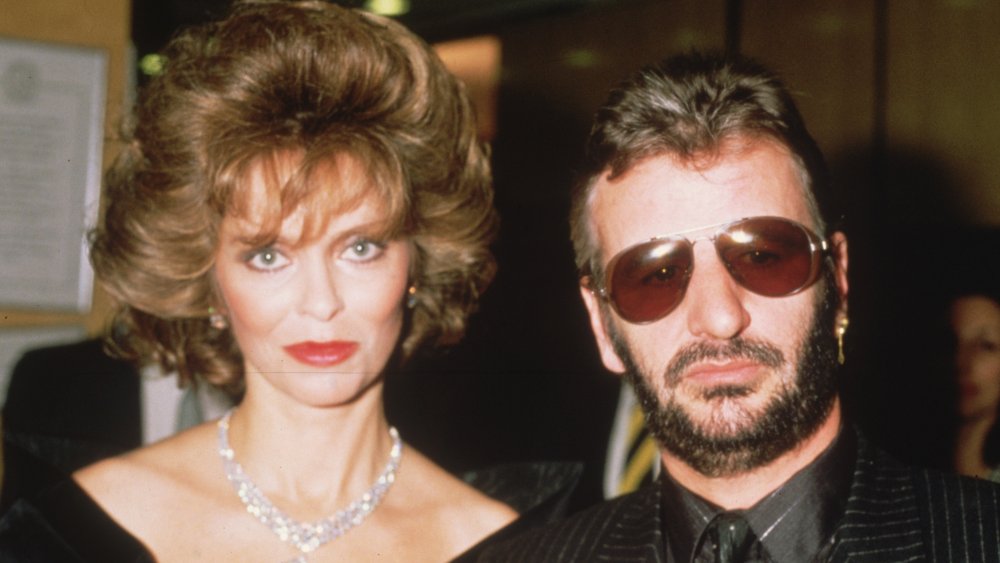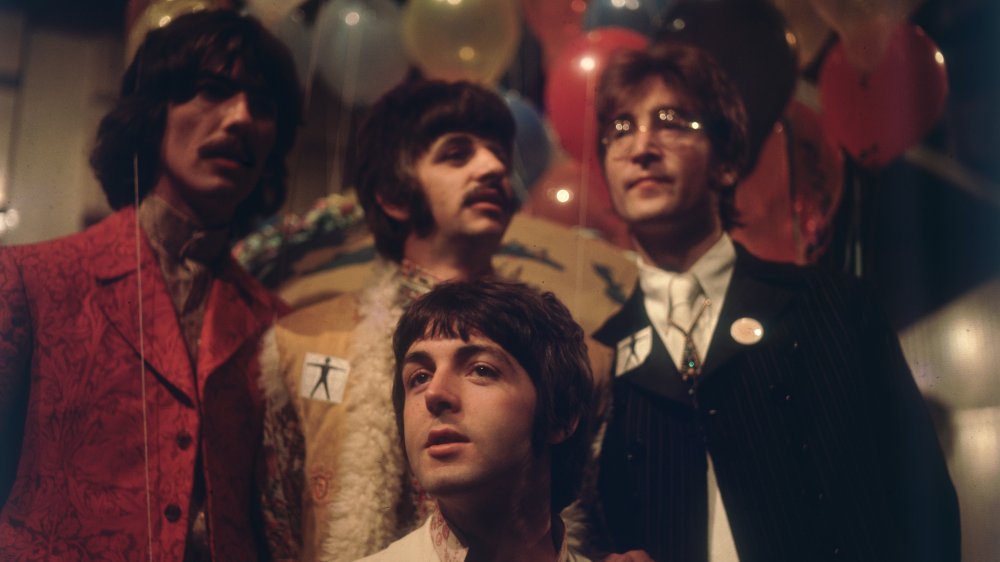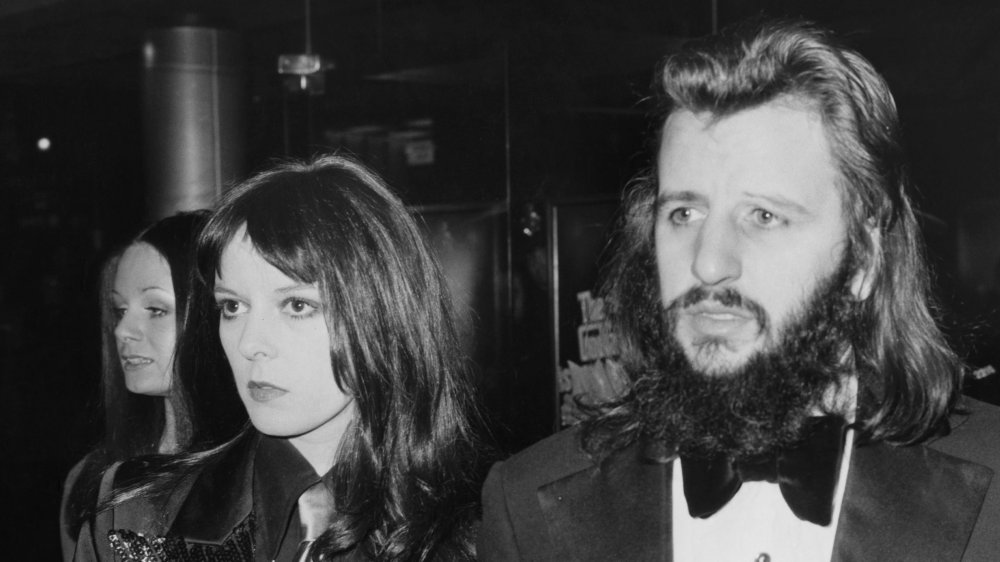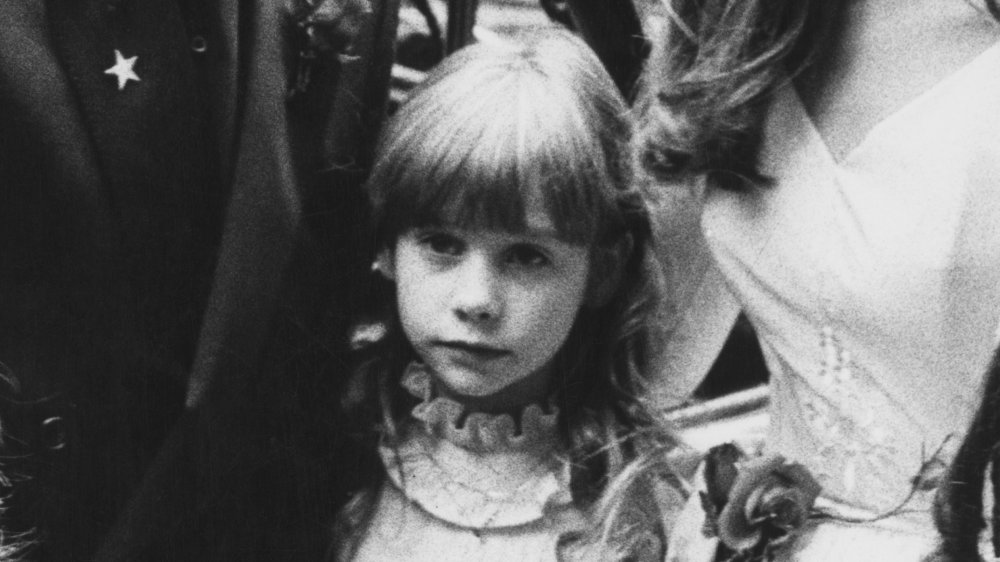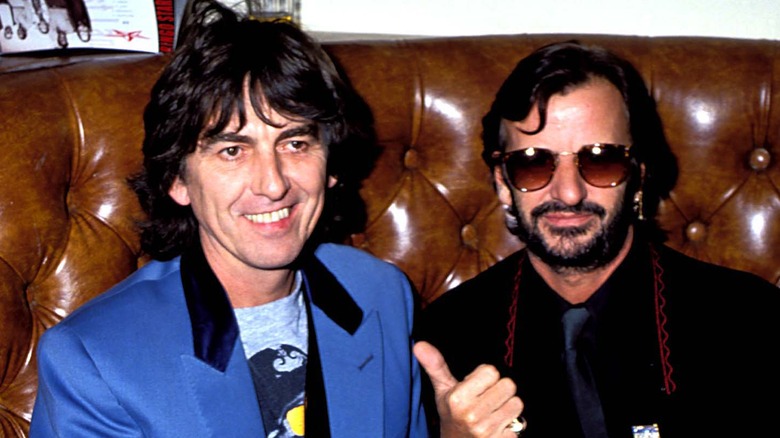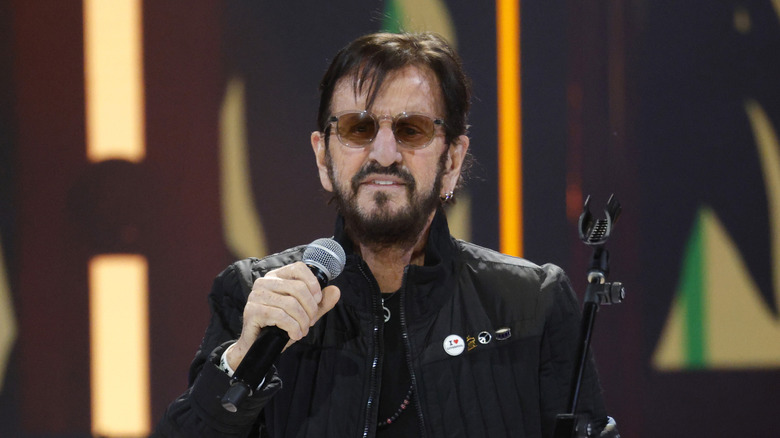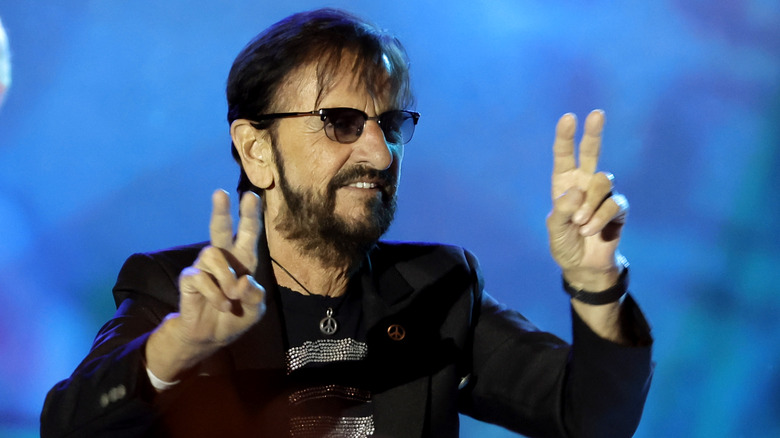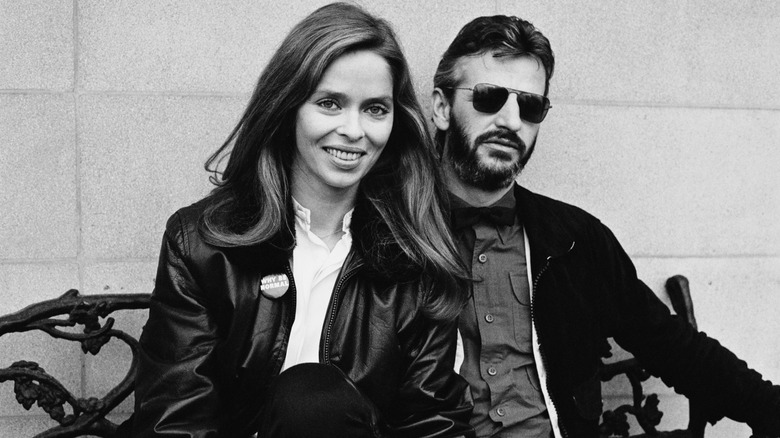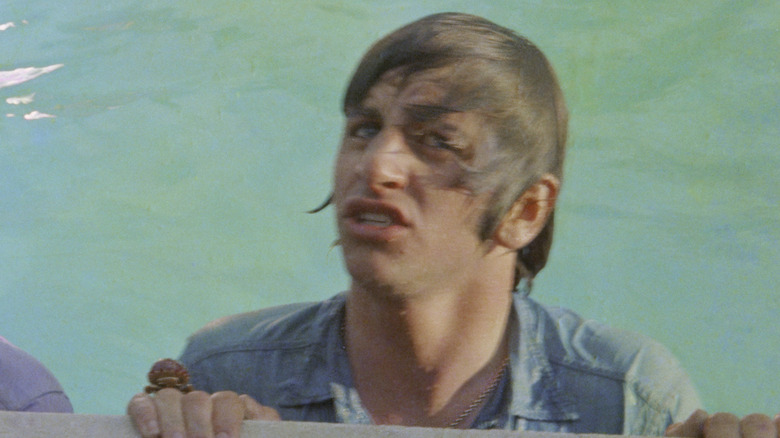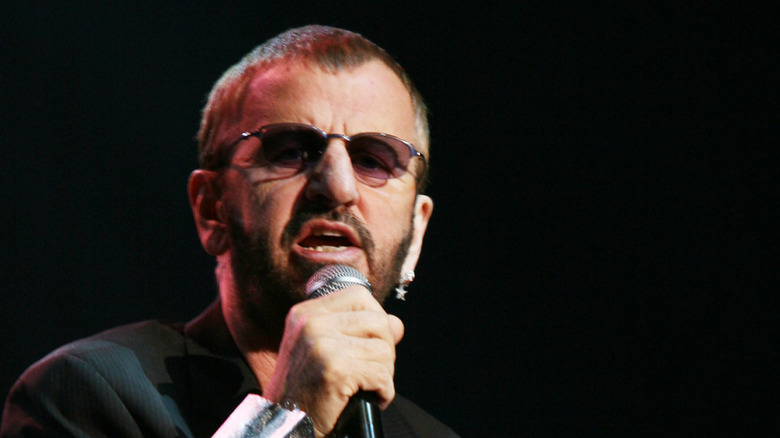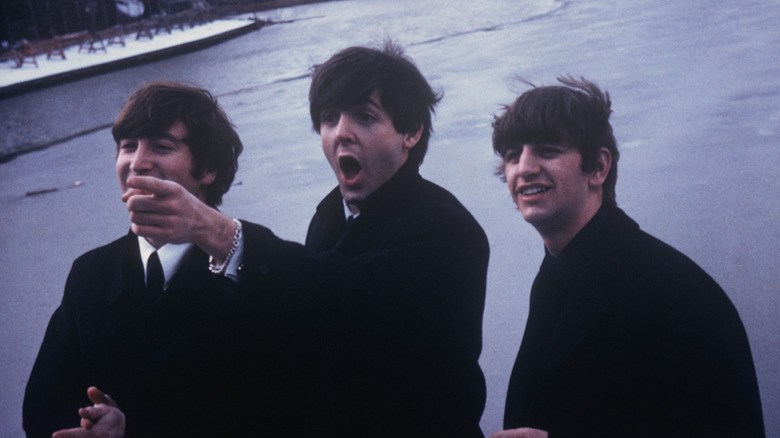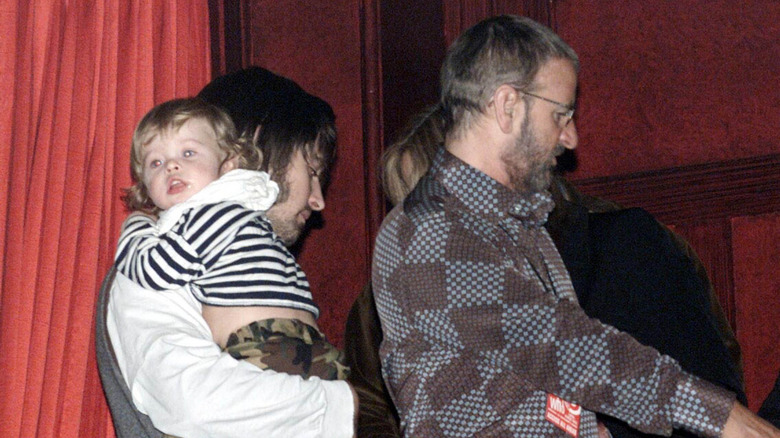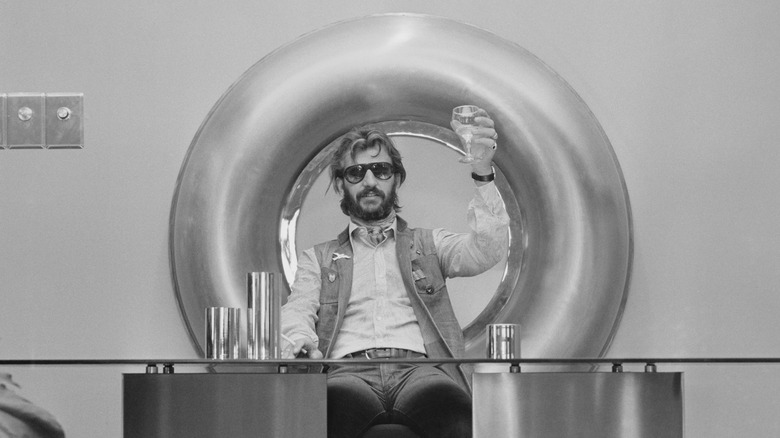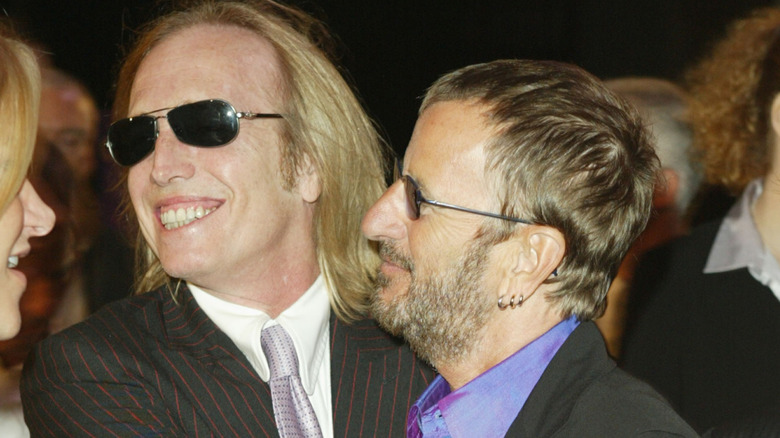The Tragic Real-Life Story Of Ringo Starr
After playing in a few Liverpool area rock bands, Richard Starkey — aka Ringo Starr — joined another group and replaced a drummer named Pete Best ... and then became one of the most famous and successful musicians ever. For that band was the Beatles, obviously, which shaped rock 'n' roll for decades to come, thanks in part to Starr sitting behind the kit and keeping the beat with his sharp, aggressive style of play.
While the Fab Four (Ringo was "the funny one") were a going concern for less than a decade, the goodwill and fortune he acquired as a Beatle propelled him through life, making him beloved and welcomed wherever he went. Sadly, his success and status as the guy talented enough to sing "Yellow Submarine" and get blisters on his fingers during "Helter Skelter" didn't insulate him from the upsetting, depressing, and unseemly side of life. Starr seems to have suffered more than his fair share of bad luck and darkness. Here are some of the more tragic events in the life of Ringo Starr.
Ringo Starr was raised in a rough neighborhood
The Beatles all famously hailed from Liverpool, one of England's largest cities and home to large populations of regular people in the working and middle classes. But while John Lennon, Paul McCartney, and George Harrison all grew up in homes that weren't wealthy but secure, Starr's upbringing was a bit more economically unstable.
"He was not a barefoot, ragged child," Starr's childhood neighbor Marie Maguire Crawford said in Bob Spitz' "The Beatles: A Biography," "but like all of the families who lived in the Dingle, he was part of an ongoing struggle to survive." The Dingle was an especially depressed neighborhood, full of tiny, decrepit homes with poor ventilation where the only place for kids to play was in a local park, where all the coal smoke from area chimneys hung thick in the air. Those circumstances were made all the more trying by Starr's father abandoning the family when Ringo was only 3 years old.
He was hospitalized for a year
Any serious medical emergency requiring a hospital stay of any length is concerning, but it seems worse when it happens to a child. And a major health calamity happened to Ringo Starr when he was just 6 years old. In 1947, his appendix ruptured, and it developed into an internal infection called peritonitis, an inflammation of a tissue membrane that covers organs. Starr's in-hospital recovery stretched on for months. "I was in a year because six months in, I was getting rather well. And I got excited and I fell out of bed and ripped open all these stitches in my stomach," he told "Fresh Air." That required an emergency surgery and then an additional six months of recovery time. Starr was laid up in a Liverpool children's hospital for so long that he missed a full year of school. When he got out, he caught up to his classmates with the aid of a tutor.
He suffered from tuberculosis
Just a few years after he spent a year in a hospital and had to work his way back up to his peers in school, Ringo Starr got waylaid by health issues yet again, and this time it was for twice as long. At the age of 13, Starr was diagnosed with one of the most frightening and potentially deadly diseases on the planet at the time — tuberculosis, a bacteria-driven condition that attacks the lungs. Catching that infectious disease was a result of "the area [he] Iived in," Starr told "Fresh Air." "It was like, you know, six or seven cases in every street where people were just in the living room dying of TB because they didn't have a cure, of course."
Doctors sent Starr to a "greenhouse in the country," a sanitarium for children where he could "breathe some decent air for a change" and receive treatments of a new miracle cure for TB called streptomycin. Starr spent around two years recovering from tuberculosis, and he missed so much school that he ultimately never returned.
Ringo missed out on part of Beatlemania
In 1964, "Beatlemania" hit big. The group's performances on "The Ed Sullivan Show" set viewership records, five Beatles songs occupied the top five slots on the Billboard Hot 100, and the band embarked on a world tour to play live in front of throngs of fans who screamed so loud they couldn't even hear the music. But during a London photoshoot in June 1964, Starr once again fell seriously ill. Taken to a hospital, he was diagnosed with both tonsillitis and pharyngitis (a severely sore throat) and was ordered by doctors to stay in bed.
That was kind of a problem, as the Beatles' first major world tour kicked off in Denmark a day later. Starr had no choice but to literally lay back and let the band replace him with producer George Martin's first suggestion, a session drummer named Jimmie Nicol. Starr recovered after 10 days, missing tour stops in Australia and Asia, and rejoined the band. It was a relief for the drummer. "They'd taken Jimmie Nicol, and I thought they didn't love me anymore," Starr said in "The Beatles Anthology" (via "The Beatles Encyclopedia"). "All that stuff went through my head."
The other Beatles were rude to him
Throughout the history of the Beatles, there's a through-line of disrespect for Ringo Starr. He was only allowed to sing lead on 11 songs and write two unassisted, and he didn't even get to play on one of the group's earliest and biggest hits. Producer George Martin didn't like the drumming Starr turned in for "Love Me Do." So he brought in a session drummer named Andy White to play drums on "Love Me Do" and the B-side "P.S. I Love You," demoting Starr to tambourine and maracas on each song, respectively.
Toward the end of the 1960s, the band life of the Beatles was famously contentious. It got so bad in 1968 for Ringo Starr that he briefly left the band in the middle of recording the album "The Beatles" (also known as "The White Album"). "I felt I wasn't playing great, and I also felt that the other three were really happy, and I was an outsider," Starr said in "The Beatles Anthology" (via "Beatles Bible"). While Starr took his family on a vacation to Sardinia, the other Beatles, apparently unfazed, recorded without him, taking bits and pieces of work he'd previously recorded and some new drum work by Paul McCartney to cobble together the rhythmic backing track for "Back in the U.S.S.R." When Starr returned, his bandmates at least welcomed him back by covering his drum kit in flowers.
Ringo Starr's solo career faltered fast
After the Beatles split up in 1970, all four members enjoyed solo success – even Ringo Starr, who was rarely featured on Beatles songs. After a false start with the flop "Beaucoups of Blues," his next seven singles (including No. 1 hits "Photograph" and "You're Sixteen") all hit the Top Ten in the U.S. The albums "Ringo" and "Goodnight Vienna" went platinum and gold, respectively, but then the public seemingly grew tired of the former Beatles drummer.
In 1976 — a year in which Paul McCartney's "Silly Love Songs" hit No. 1 — Starr's "Ringo's Rotogravure" stalled at No. 28 on the album chart, and singles "A Dose of Rock 'n' Roll" and "Hey! Baby!" tanked, too. His 1977 and 1978 records "Ringo the 4th" and "Bad Boy" straight-up flopped, reaching No. 162 and No. 129 on the Billboard album chart, respectively. After leaving his label over a dispute, it took Starr three years to record and release more music, with 1981's "Stop and Smell the Roses." He enjoyed a modest comeback with the No. 38 hit "Wrack My Brain," a song written by former bandmate George Harrison. But "Stop and Smell the Roses" sold so poorly that RCA Records dropped Starr. That's right. After reaching new heights as a member of the Beatles, Starr was left without a recording contract.
He had a serious problem with alcohol
The breakup of the Beatles in 1970 left Ringo Starr feeling "absolutely lost," as he told People, and stress over an unsteady solo career in the years after left him with a "serious drinking problem" that only intensified. "It got progressively worse, and the blackouts got worse, and I didn't know where I'd been, what I'd done," he said. He doesn't even remember some career highlights. "I've got photographs of me playing all over the world but I've absolutely no memory of it. I played Washington with the Beach Boys — or so they tell me," Starr told the Daily Express. "But there's only a photo to prove it."
In 1989, he went to court to stop the release of an album he'd recorded during an especially booze-heavy period, testifying that he was drinking as many as 16 bottles of wine each day. Starr realized he had a problem in the early '80s, but he didn't seek help for years because he felt like he was stuck, professionally. "I don't know how you do anything if you're not drunk," he recalled feeling to Rolling Stone, adding, "I couldn't play sober, but I also couldn't play as a drunk." He credits forming his Ringo Starr's All-Starr Band and going on a tour in 1989 as one of the main factors that helped him kick alcohol for good.
Ringo got so drunk his staff thought he killed his wife
Not only did addiction ensnare Ringo Starr, he says it also grabbed his second wife, actress Barbara Bach. "She fell into the trap because of me," he told People. Starr added that Bach would "try and straighten us out" on occasion, but they'd fall back into old habits. "We used to go on long plane journeys, rent huge villas, stock up the bars, hide, and get deranged," Starr and Bach wrote in the foreword to "Getting Sober...And Loving It" (via The Independent), a book about alcoholism by former Beatles press officer Derek Taylor. As Bach's daughter, Francesca Gregorini, told The Mail on Sunday (via a Beatles fan site), when she lived with her mother and the former Beatle, "it was their drugs heyday," and they were content to just "stay at home, drink, do drugs, and just hide away."
Such a lifestyle may have hit its nadir in late 1988. "I came to one Friday afternoon and was told by the staff that I'd trashed the house so badly they thought there had been burglars, and I'd trashed Barbara so badly they thought she was dead," Starr is quoted as saying in Andrew Grant Jackson's Beatles biography "Still the Greatest." In October 1988, Starr and Bach jointly checked into a rehab facility in Tucson, Arizona.
His friend and bandmate was murdered
In December 1980, a troubled fan named Mark David Chapman shot and killed former Beatles frontman John Lennon outside of his New York City apartment building, a sad and tragic event that disturbed millions of fans. If it certainly upset all the people who grew up listening to the Beatles, it was devastating to somebody who was in the Beatles with Lennon.
"I was in the Bahamas," Starr told Rolling Stone about the night he heard about the death of his friend. "I was getting a phone call from my stepkids in LA, saying, 'Something's happened to John.' And then they called and said, 'John's dead.' And I didn't know what to do." Immediately, Starr hopped on a plane to New York and went to the apartment Lennon shared with his wife, Yoko Ono, and their young son, Sean. Starr hung out for a while, offering comfort and support, playing with Sean and keeping him occupied to take his mind off the tragedy. Despite his brave face, there's no doubt that the tragedy absolutely wrecked Starr.
His first wife died after a bout with leukemia
Ringo Starr met his first wife, the former Maureen Cox, at the Cavern Club, the venue where the Beatles cut their teeth. "Here I was, a silly 16-year-old hairdresser dating the most popular drummer in Liverpool," Cox told Le Chroniqueur (via The Daily Beatle) in 1988. The pair wed in 1965 and had three children together, and the marriage weathered the storm of worldwide fame and attention — but just barely and not for the long haul. Cox had a brief affair with Starr's Beatles cohort George Harrison, and after they grew apart in the mid-'70s, Starr struck up a relationship with model Nancy Lee Andrews, with a divorce finalized in 1975. According to John Lennon's first wife, Cynthia, Cox was so devastated that she attempted to take her own life by running a motorcycle into a wall. She survived, but she endured a lengthy cosmetic surgery to correct her facial injuries.
Starr and Cox both remarried — he to actress Barbara Bach, she to Hard Rock Café founder Isaac Tigrett — but they reportedly remained cordial. They stayed so friendly, in fact, that Starr was with his former wife when she passed away in December 1994. Admitted to the Fred Hutchinson Research Center in Seattle the previous October, Cox underwent a bone marrow transplant from her and Starr's son, Zak Starkey, that was intended to treat leukemia. Sadly, the procedure didn't completely improve her health, and Maureen Cox died from complications of the surgery at age 47.
Ringo Starr's daughter fought off brain tumors
During 1970 — the same year of the momentous Beatles split — Ringo Starr at least had something to celebrate in his personal life: the birth of his first daughter (and third child overall), Lee Starkey. While she stayed out of the spotlight for decades — as opposed to more famous Beatles offspring like fashion designer Stella McCartney and '80s pop sensation Julian Lennon — Starkey operated a retro boutique but made headlines in the fall of 1995 for a very troubling matter.
After collapsing and being hospitalized in London, Starkey was diagnosed with a brain tumor. Doctors drained fluid from her skull, she was transferred to Brigham and Women's Hospital in Boston, where neurosurgeon Dr. Peter Black performed an experimental four-hour operation on Starkey. The tumor — of an eminently curable kind called ependymoma — was removed entirely, and Starkey was quickly discharged. The patient's father was reportedly by his daughter's bedside for the ordeal, and he stayed with her in Boston for six weeks after, when Starkey underwent eight-minute radiation treatments every day. Concerningly, in 2001, the tumor reportedly returned, and Starkey had to endure more medical treatments.
The death of George Harrison profoundly hurt Ringo Starr
In 1970, the Beatles broke up under a cloud of creative and personal differences, but hostilities between all four musicians would eventually ease and they'd all be friendly again while also frequently contributing to one another's solo projects. For example, following the death of John Lennon in 1980, Ringo Starr appeared on George Harrison's hit 1981 Beatles reflection tune "All Those Years Ago," and they'd both play on "Free as a Bird," a 1995 single credited to the Beatles built out of an unused John Lennon demo recording. Just six years after that reunion (which also involved Paul McCartney), Harrison would become the second Beatle to die. In November 2001, Harrison died at age 58 following years of treatment for cancer.
Starr was aware that his cohort didn't have much time left when he went to visit him at his home in Switzerland in late 2001. "He was very ill. He could only lay down. And while he was being ill and I had come to see him, I was going to Boston 'cause my daughter had a brain tumor," Starr said in the documentary "George Harrison: Living in the Material World" (via Far Out). "It was the last words I heard him say, actually. He said, 'Do you want me to come with you?'"
He was extremely ill throughout the 2020s
For decades, Ringo Starr has proudly discussed his healthy lifestyle habits. He adopted a vegetarian diet in the early 1990s, embraced holistic and natural medical techniques, and even into his 80s, he regularly exercises and works out. By 2022, he reportedly became very upset after a physical health crisis. That year, the 82-year-old musician contracted a strain of the potentially and often deadly COVID-19 virus. Starr made a full recovery, but he had little choice but to cancel a series of tour dates. When he did feel well enough to perform, he chose to stay off the road and rest so as not to overtax his system.
Just after his COVID-19 experience, Starr was diagnosed with another severe ailment. "It was a mad thing eating my body, and they found out when they took my blood," he explained. Starr exhibited a tremendously high white blood cell count. Those cells fight invading pathogens, and a large number of them indicates that his body was fighting off a particularly strong infection. "They were fighting the attacker. And so with pills and medication, I got over it in two weeks," Starr told Variety. He still had to cancel multiple tour dates, however.
Ringo Starr got caught up in a financial mess
In 2021, the International Consortium of Investigative Journalists published an exposé on the use of creative accounting methods and international money placement by wealthy celebrities. In other words, the report known as the "Pandora Papers" uncovered evidence of tax shelters. The ICIJ alleged that the rich people it looked into had established companies in the British Virgin Islands, Switzerland, Anguilla, and other locales, where taxes on income are extremely low or non-existent. Stars' funds were then funneled through those accounts so they wouldn't count as taxable income in their home nations. Along with the likes of Shakira and Julio Iglesias, Ringo Starr was among the famous people named in the documents.
At the time when the report went public in October 2021, Starr's net worth was in the $400 million range. The ICIJ found the documents that showed Starr, or an agent acting on his behalf, had set up two separate companies technically located in the Bahamas, which were then used to buy a home in the Los Angeles area. The musician additionally created five trusts in the small-taxing nation of Panama. One trust received the money generated by Starr's royalty payments and concert performances, while three others owned life insurance policies that benefited Ringo Starr's adult children.
He almost died in a car accident
Three years after the tragic death of T. Rex's Marc Bolan in a car accident, and less than a mile from the site of the tragedy, that musician's friend, Ringo Starr, was involved in a brutal vehicular mishap of his own, and one from which he only barely and literally walked away. Only months after their relationship began during the filming of the movie "Caveman," Starr and Barbara Bach headed to a party in the Surrey area of England on May 19, 1980. As Starr drove his Mercedes through foggy conditions on the A3 road, he came across the Robin Hood Roundabout and didn't see a large truck heading his way. At a speed of about 60 miles per hour, Starr quickly swerved to avoid a direct head-on collision but lost control of the vehicle in the process. The car came to rest around 50 yards away from the point of near-impact, sliding and turning over on itself repeatedly as it traveled. It only stopped when and where it did because of two lamp posts.
Starr injured his leg in the crash, but he remained conscious, and he managed to find the strength to extract Bach from the totaled vehicle and ensure that she was safe. After Starr returned to the destroyed Mercedes to get a pack of cigarettes, he and Bach were taken to a hospital and treated for minor injuries. Starr proposed marriage three weeks later.
Ringo Starr needed help during the filming of Help!
Besides the Beatles themselves, only actor Victor Spinetti appeared in all of the band's live-action scripted films. Friendly with the Fab Four by the time they all made "Help!" in the Caribbean in 1965, Spinetti extracted Ringo Starr from a possibly life-threatening situation. In the movie, Spinetti played a villain who wanted to take away a valuable ring worn by Ringo, and the script called for Starr to get away by jumping off of a yacht into the sea. It was the first scene captured for "Help!," and Starr did his own stunts. "So he dives off but quickly comes straight back out shivering because it was freezing and there were shark nets everywhere — it was actually very dangerous," Spinetti said at a Beatles fan convention in 2009 (via Wales Online).
The director planned to just shoot one take, but there was some kind of error, necessitating Starr to jump in the water again — and then once more. Finally, he confided his urgent apprehensions with Spinetti. "The third time he was being dried off with a hairdryer and he said: 'Oh, Victor, I don't want to do this again.' I asked why and he replied, 'Because I can't bloody swim,'" Spinetti recalled. The actor alerted the film crew, which decided at that point that it could make do with the footage it had filmed rather than risk Starr's safety or death for a fourth time.
Quebecois separatists threatened to kill Ringo Starr
With Beatlemania at its height in 1964, the Beatles' North American tour took the band into Canada for a gig in Toronto and two shows in one day at The Forum in Montreal. When the group arrived at Dorval Airport, 120 members of the Royal Canadian Mounted Police did too, specifically to help protect Ringo Starr. Montreal is the largest city in Quebec, a province culturally and linguistically aligned with France, as opposed to the more English-skewing rest of Canada. French-Canadian separatist groups calling for Quebecois independence have long operated out of the region, and before the Beatles came to Montreal, one with an antisemetic bent sent death threats to the drummer. "Some people decided to make an example of me, as an English Jew. The one major fault is, I'm not Jewish," Starr later said in "The Beatles Anthology" (via "The Beatles in America 1964.") "Threats we took in our stride. I mean, suddenly there would be a few more cops. But this was one of the few times I was really worried."
As the Beatles performed the 4 p.m. and 8:30 p.m. shows at The Forum, many firm but subtle security measures were instituted. A non-uniformed police officer sat near Starr throughout the concerts, while police snipers were placed around the venue. "I had the cymbals up towards the audience to give me a bit of protection. I usually had them flat," Starr recalled. No attempt on the drummer's life materialized, though, and the band safely left town after the final show.
The end of the Beatles was a tough time for Ringo Starr
In April 1970, Paul McCartney announced he was taking some time off from the Beatles, and the temporary split turned permanent by the end of the year. The Beatles' breaking up wasn't a surprise, as the situation inside the band had been growing tense and unworkable since at least August 1968, during the recording of the band's self-titled LP better known as "The White Album." "Things were getting very strained on Beatles sessions by this time. The engineers would be asked to leave," engineer Peter Vince disclosed in "The Beatles Recording Sessions." "And you'd know they were having heavy discussions and didn't want anyone around."
When the band actually did fall apart in 1970, Starr took it harder than the actively departing McCartney and John Lennon, and George Harrison, who was already at work on solo projects. "I was mad. For 20 years. I had breaks in between of not being mad," he told the Times of London in 2015. Starr used heavy drinking to cope with the loss. It would serve to ultimately wipe many of his memories of the immediate post-Beatles era. "I was drunk," he said. "Some of those years are absolutely gone.
He's had a strained relationship with one of his sons
While still married to his first wife, Maureen, Ringo Starr welcomed two sons in 1965 and 1967, respectively: Zak and Jason. The elder Starkey followed his father into the family business and became a professional rock drummer in demand, playing with Oasis, the Waterboys, and The Who. Starr's other son, Jason Starkey, also trained as a drummer, but has had a tougher run in the wake of a sometimes-contentious relationship with his famous father. At one point, he blamed whatever hardship he'd experienced in part on his parentage. "Being Ringo's son is the biggest drag in my life. It's a total pain," he told an interviewer (via The Independent). Jason Starkey performed with a string of bands before he gave up drumming for good in favor of being a photographer and a tour manager.
Starr's youngest son also found himself on the wrong side of the law when he was in his 20s. In 1987, Jason Starkey was found guilty of stealing a car radio, and he incurred a £125 fine. Two years later, he went before a judge on a drug possession charge.
Ringo Starr's vanity record label tanked quickly and thoroughly
After Apple Records began closing up in 1974, Ringo Starr was temporarily without any kind of record label. So, in mid-1975, he started his own: Ring O' Records. While he was ostensibly in charge of the label bearing his stage name, Starr signed deals with giant record companies to distribute his boutique's releases, Polydor Records in the U.K. and Atlantic Records in the United States. Unfortunately, the next chapter of the former Beatle's career as a solo musician, and his first as a label boss, proved simultaneously and woefully unsuccessful. None of Starr's late-'70s albums made for his own brand produced a hit single. ("A Dose of Rock 'n' Roll" in 1976 made it midway up the pop charts in the U.S. and the U.K.) The album "Ringo's Rotogravure" flopped hard on both sides of the Atlantic despite including all three of Starr's former Beatles bandmates on various tracks.
Apart from Starr, the Ring O' Records output wasn't very notable. Failing to sign a marquee act when his friend Harry Nilsson opted to resign with RCA Records instead of jumping to Ring O', Starr settled on releasing music by little-known acts who never broke through commercially, including obscurities like Johnny Warman, Stormer, Suzanne, David Hentschel, and Bobby Keyes. After three years as a failing business, Starr dissolved Ring O' Records at the end of 1978.
His good friend Tom Petty died suddenly
Just after completing a 40th anniversary Tom Petty and the Heartbreakers tour, Tom Petty died on October 2, 2017. The cause of death for the 66-year-old musician was an accidental overdose of prescription painkillers, which Petty used to cope with a series of serious medical problems, including a fractured then fully broken hip, which left him in tremendous agony during those final concerts.
Ringo Starr and Petty were friends and colleagues, with the drummer making a cameo appearance in the latter's 1989 music video "I Won't Back Down." The death of Petty seriously unnerved Starr. He received the news when he was in Las Vegas for a concert, one day after a shooting at the Route 91 Harvest Festival left 50 people dead and about 400 injured. "Tom was a good friend. I played with Tom, Tom played with me. I got to know him over the years, really got to know him when he was in the Wilburys," Starr told Billboard, referring to his fellow former Beatle George Harrison's supergroup the Traveling Wilburys. "All through my career we've lost really great friends, and people who aren't my friends, but were great musicians and writers. In our business we've lost them very young as well."
If you or anyone you know needs help with addiction issues or is struggling or in crisis, contact the relevant resources below:
- The Substance Abuse and Mental Health Services Administration website or contact SAMHSA's National Helpline at 1-800-662-HELP (4357)
- Call or text 988 or chat 988lifeline.org
